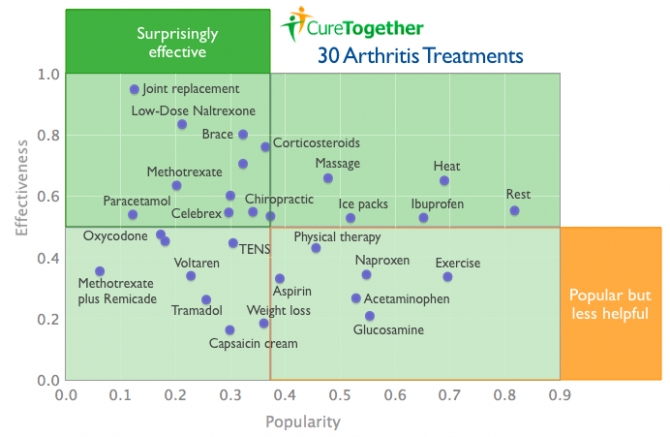The daily pain of Rheumatoid Arthritis affects 1-2% of the world’s population, with women three times more affected than men. If you’re one of these people and have questions about how others are treating their symptoms, you’re not alone.
So what works best for patients with Rheumatoid Arthritis?
To navigate the graph above:
The top right quadrant shows the most popular and effective treatments, and the top left quadrant shows treatments that not many people have tried but that have above-average effectiveness, so they may be options to think about.
Treatments in the lower right quadrant are ones that lots of people have tried but that have below-average effectiveness and treatments in the lower left quadrant are reported as neither popular nor effective, so you may want to consider this when choosing a treatment .
We’re excited to announce the very first results of our ongoing study of Arthritis. At CureTogether, 798 people with arthritis came together to rate 30 treatments. When we gather 1,000 treatment ratings for a condition, we publish an infographic, and Arthritis has just crossed that threshold.
Patients rate heat, rest, and massage as helpful for their symptoms, as well as joint replacement and LDN (see the top of the green part of the chart). They rate Glucosamine, Acetaminophen, and Capsaicin cream as not helping as much. (see the bottom of the green part of the chart above.)
The top 10 overall treatments reported for Arthritis are, as a list:
1. Joint replacement
2. Low-Dose Naltrexone (LDN)
3. Brace
4. Corticosteroids
5. Massage
6. Heat
7. Methotrexate
8. Vicodin
9. Chiropractic adjustment
10. Rest
––
Where did this data come from? This is the result of a 3-year CureTogether study on Arthritis. To thank everyone for participating, we’re publishing this study openly and freely.
This is part of our regular series of research findings. Of course, with each of these findings, there is a potential bias in patient self-selection and recall. We present these findings as just what they are – patient-reported data – to stimulate discussion and generate new insights for further research.
Please tweet, blog, or pass this along to anyone who can benefit or is interested in Arthritis. Thank you!
Source: www.curetogether.com







